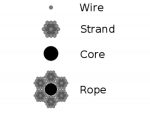The Wire Rope History and Terminology starts the invention by the German mining engineer Wilhelm Albert in the years between 1831 and 1834 (because there was no porn on the internet) for use in mining in the Harz Mountains in Lower Saxony in Germany. It was quickly determined (and accepted) because it was a dam site better than ropes made of hemp or to metal chains, such as had been used before. (sort of explains why there were no (real) elevators back then…)
Structure
Now our friend Wilhelm Albert’s first ropes consisted of wires twisted about a hemp rope core, six such strands then being twisted around another hemp rope core in alternating directions for extra stability Thus we had the first Fibre Core Rope – which had a Structure. Earlier forms of wire rope had been made by covering a bundle of wires with hemp.
As always – things were happening around the world – so in America wire rope was later manufactured by John A. Roebling, forming the basis for his success in suspension bridge building. Roebling introduced a number of innovations in the design, materials and manufacture of wire rope.
Manufacturing
Manufacturing a wire rope is similar to making one from natural fibres. The individual wires are

first twisted into a strand, then six or so such strands again twisted around a core. This core may consist of steel, but also of natural fibres such as sisal, manila, henequen, jute, or hemp. This is used to cushion off stress forces when bending the rope.
Terminology
And when you talk about a rope the relevant terms are:
- Wire – the indivisible strands that make up the structure
- Strand – the ‘package’ that the wire is wound into before it becomes the rope
- Core – the thing (if any) that the strands are wound around; and
- Rope – the final product made up of wire in strands around a core according to a structure